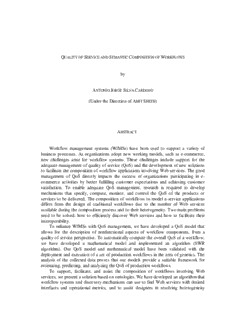Table Of ContentQUALITY OF SERVICE AND SEMANTIC COMPOSITION OF WORKFLOWS
by
ANTONIO JORGE SILVA CARDOSO
(Under the Direction of AMIT SHETH)
ABSTRACT
Workflow management systems (WfMSs) have been used to support a variety of
business processes. As organizations adopt new working models, such as e-commerce,
new challenges arise for workflow systems. These challenges include support for the
adequate management of quality of service (QoS) and the development of new solutions
to facilitate the composition of workflow applications involving Web services. The good
management of QoS directly impacts the success of organizations participating in e-
commerce activities by better fulfilling customer expectations and achieving customer
satisfaction. To enable adequate QoS management, research is required to develop
mechanisms that specify, compute, monitor, and control the QoS of the products or
services to be delivered. The composition of workflows to model e-service applications
differs from the design of traditional workflows due to the number of Web services
available during the composition process and to their heterogeneity. Two main problems
need to be solved: how to efficiently discover Web services and how to facilitate their
interoperability.
To enhance WfMSs with QoS management, we have developed a QoS model that
allows for the description of nonfunctional aspects of workflow components, from a
quality of service perspective. To automatically compute the overall QoS of a workflow,
we have developed a mathematical model and implemented an algorithm (SWR
algorithm). Our QoS model and mathematical model have been validated with the
deployment and execution of a set of production workflows in the area of genetics. The
analysis of the collected data proves that our models provide a suitable framework for
estimating, predicting, and analyzing the QoS of production workflows.
To support, facilitate, and assist the composition of workflows involving Web
services, we present a solution based on ontologies. We have developed an algorithm that
workflow systems and discovery mechanisms can use to find Web services with desired
interfaces and operational metrics, and to assist designers in resolving heterogeneity
issues among Web services. Our approach provides an important solution to enhance
Web service discovery and interoperability.
INDEX WORDS: workflow management systems (WfMSs), quality of service (QoS),
workflow composition, web services, business process management.
QUALITY OF SERVICE AND SEMANTIC COMPOSITION OF WORKFLOWS
by
ANTONIO JORGE SILVA CARDOSO
Licenciatura, University of Coimbra, Portugal, 1995
Mestrado, University of Coimbra, Portugal, 1998
A Dissertation Submitted to the Graduate Faculty of The University of Georgia in Partial
Fulfillment of the Requirements for the Degree
DOCTOR OF PHILOSOPHY
ATHENS, GEORGIA
2002
ª 2002
Antonio Jorge Silva Cardoso
All Right Reserved
QUALITY OF SERVICE AND SEMANTIC COMPOSITION OF WORKFLOWS
by
ANTONIO JORGE SILVA CARDOSO
Approved:
Major Professor: Amit Sheth
Committee: Christoph Bussler
John Miller
Jonathan Arnold
Krys Kochut
Robert Bostrom
Electronic Version Approved:
Gordhan L. Patel
Dean of the Graduate School
The University of Georgia
August 2002
DEDICATION
To my parents and brothers.
iv
ACKNOWLEDGMENTS
This dissertation is part of the group effort to enhance the METEOR workflow system at
the Large Scale Distributed Information System (LSDIS) Laboratory of the Department
of Computer Science at the University of Georgia. I wish to acknowledge several people
who have been particularly helpful and supportive during my research. First, I would like
to thank my major advisor Amit Sheth for his support of my studies. I also wish to thank
John Miller for having played the devil’s advocate so many times, advancing my research
always a step further. I thank Arnold Jonathan for his help and valuable input on
technical matters related to genetic processes. Thanks to Robert Bostrom and Krys
Kochut for their advice, encouragement, and assistance. Thanks also to Christoph Bussler
for joining my committee. Special thanks go to António Dias de Figueiredo for his
support and encouragement during my Ph.D. program. I cannot close without a final
word of thanks to my friends and colleagues at the LSDIS laboratory: Kemafor
Anyanwu, Ketan Bhukanwala, Sonali Sheth, Zhongwei Luo, Zhongqian Li, Wil M. P.
van der Aalst, David Hall, and Madalena Lordelo.
This work was supported by the European Social Fund (FSE), III Community Frame
for Support (QCA), and by the Portuguese Ministry of Science and Technology (MCT).
v
TABLE OF CONTENTS
ACKNOWLEDGMENTS......................................................................................................V
CHAPTER 1 – INTRODUCTION AND LITERATURE REVIEW...................................................1
1.1 WORKFLOW MANAGEMENT SYSTEMS...............................................................2
1.2 WORKFLOW MANAGEMENT SYSTEMS EVOLUTION............................................3
1.3 MOTIVATION....................................................................................................3
1.4 WORKFLOW QUALITY OF SERVICE....................................................................5
1.5 SEMANTIC WORKFLOW COMPOSITION...............................................................9
1.6 MAJOR RESULTS.............................................................................................11
1.7 INTENDED AUDIENCE......................................................................................12
1.8 DISSERTATION ORGANIZATION.......................................................................12
1.9 REFERENCES...................................................................................................14
CHAPTER 2 – MODELING QUALITY OF SERVICE FOR WORKFLOWS AND WEB SERVICE
PROCESSES....................................................................................................................20
2.1 ABSTRACT......................................................................................................21
2.2 INTRODUCTION...............................................................................................21
2.3 SCENARIO.......................................................................................................26
2.4 WORKFLOW QUALITY OF SERVICE..................................................................32
2.5 CREATION OF QOS ESTIMATES........................................................................42
2.6 QOS COMPUTATION........................................................................................47
2.7 WORKFLOW QOS COMPUTATION EXAMPLE.....................................................63
2.8 RELATED WORK.............................................................................................75
vi
2.9 FUTURE WORK...............................................................................................77
2.10 CONCLUSIONS................................................................................................79
2.11 REFERENCES...................................................................................................81
CHAPTER 3 – IMPLEMENTING QUALITY OF SERVICE FOR WORKFLOW MANAGEMENT
SYSTEMS........................................................................................................................91
3.1 ABSTRACT......................................................................................................92
3.2 INTRODUCTION...............................................................................................92
3.3 RELATED WORK.............................................................................................95
3.4 WORKFLOW QUALITY OF SERVICE..................................................................96
3.5 WORKFLOW QOS IMPLEMENTATION ...............................................................99
3.6 WORKFLOW QOS ANALYSIS AND SIMULATION..............................................119
3.7 CONCLUSIONS..............................................................................................123
3.8 APPENDIX.....................................................................................................124
3.9 REFERENCES.................................................................................................128
CHAPTER 4 – SEMANTIC E-WORKFLOW COMPOSITION..................................................134
4.1 ABSTRACT....................................................................................................135
4.2 INTRODUCTION.............................................................................................135
4.3 SCENARIO.....................................................................................................141
4.4 WORKFLOW TASKS AND WEB SERVICE TASKS..............................................144
4.5 THE E-WORKFLOW COMPOSITION PROCESS...................................................152
4.6 MATCHING ST AND SO.................................................................................157
4.7 SYSTEM ARCHITECTURE...............................................................................182
4.8 RELATED WORK............................................................................................186
4.9 CONCLUSIONS..............................................................................................189
4.10 REFERENCES.................................................................................................191
vii
CHAPTER 5 – CONCLUSIONS.........................................................................................200
APPENDIX A – THE DNA SEQUENCING WORKFLOW.....................................................204
A.1 INTRODUCTION.............................................................................................204
A.2 INTRODUCTION TO GENOMICS.......................................................................205
A.3 DNA SEQUENCING WORKFLOW DESCRIPTION...............................................206
A.4 ACKNOWLEDGEMENTS..................................................................................215
A.5 REFERENCES.................................................................................................216
viii
Description:Our QoS model and mathematical model have been validated with the deployment and execution of a set of production workflows in the area of genetics . The.

